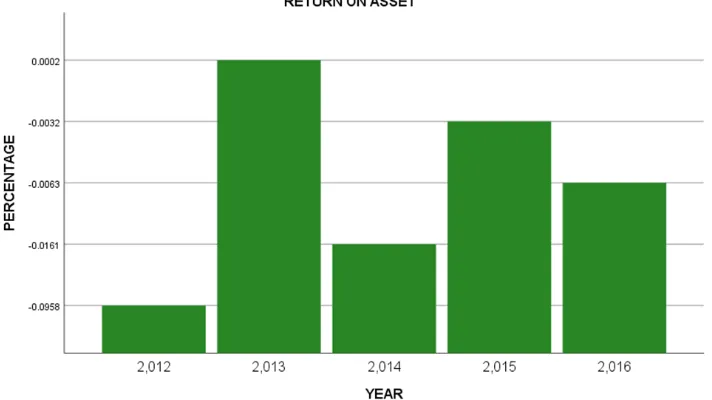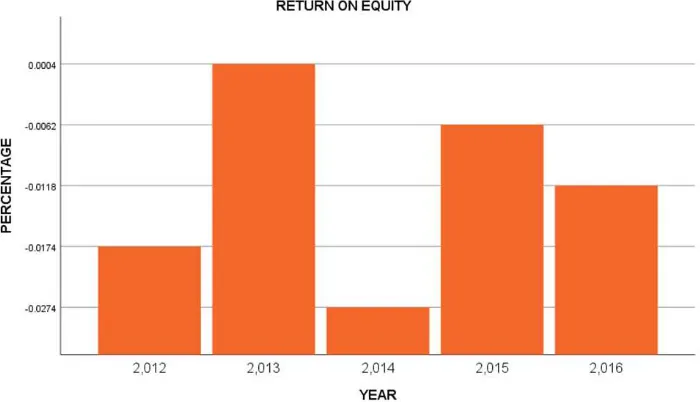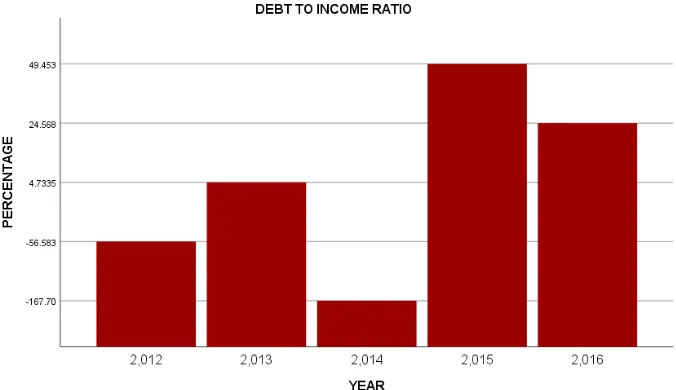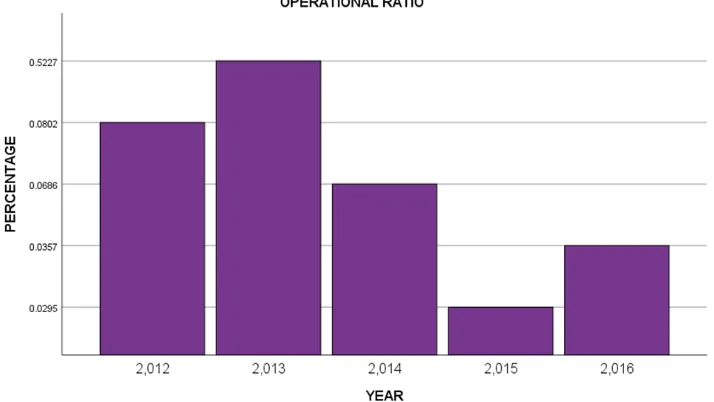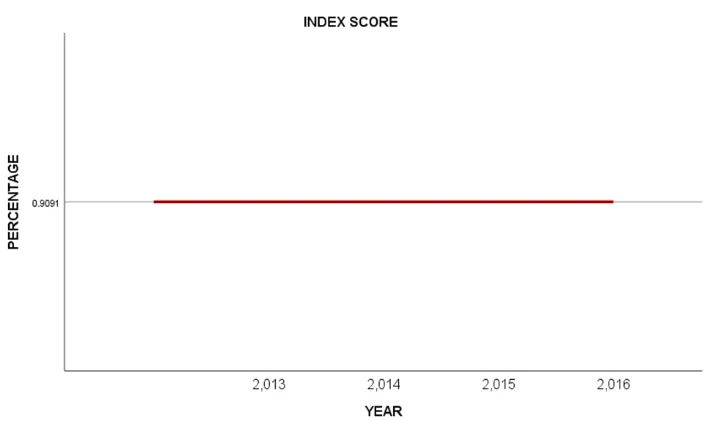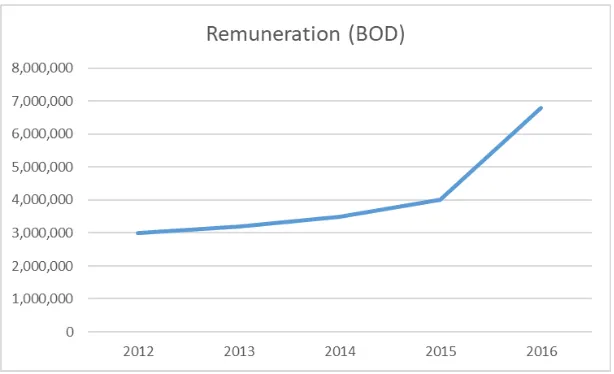Munich Personal RePEc Archive
Corporate Governance and Performance
of Hotel Industry (Ihi)
Abdullah, Nur Shahila
Universiti Utara Malaysia
20 April 2018
CORPORATE GOVERNANCE AND PERFORMANCE OF HOTEL INDUSTRY
(IHI)
Nur Shahila binti Abdullah
School of Economic, Finance and Banking, Universiti Utara Malaysia (UUM), Sintok, Kedah, MALAYSIA
Abstract
The aim of this study is to analyse the performance of hotel industry in United Arab Emirates during five years. This study was carried out using the secondary data which was obtained from the annual reports of five companies in consecutive years from 2012 until 2016. Return on asset (ROA) has been as the dependent variable to study its relationship with the independent variables such as Return on Equity (ROE), unemployment rate, exchange rate and other risk factor variables. The enter method was used to obtain the correlation and regression result to observe the significance level of the risk with the profits. The finding show that the company performance can be influenced by the risk and economic environment.
Keywords: Profitability, ROA, ROE, Exchange rate, Unemployment rate
1.0INTRODUCTION
Background of Industry
International Hotel Investments (IHI) was launched as a publicly traded company in 2000 by Corinthia Palace Hotel Company Limited (CPHCL), with the intention to acquire, develop and operate upscale hotels and ancillary real estate, in Europe and beyond, principally in fast-evolving
destinations. IHI’s investments to date have featured a combination of new construction landmark developments, as also the acquisition of existing hotels, where IHI has maximised the business potential of each of the acquired hotels by way of major refurbishment and expansion projects. Typically, IHI has targeted investment opportunities in emerging markets as also established
destinations, unlocking hidden value in landmark real estate. IHI’s policy is to achieve the
maximum benefit through capital gains in redevelopment, as also healthy operating results with ultimate appreciation of the property over the years. To date, IHI has acquired and developed seven landmark hotel projects, in Prague (Czech Republic), Tripoli (Libya), Lisbon (Portugal), Budapest
(Hungary), St Petersburg (Russian Federation), St George’s Bay (Malta) and in London (United Kingdom).
developments in the hotel sector, IHI is also a strategic shareholder in QP Management Limited, a construction project management company having a specialist track record in the management of major hotel construction and refurbishment projects in a wide range of countries. Through this association, IHI is reassured of its interests in all its hotel projects, adopting an intimate, direct involvement in the planning and execution of investment projects. CPHCL is a joint venture between the Pisani family of Malta and the Libyan Foreign Investment Company (LAFICO), which joined the company in 1974. CPHCL has since grown to be the leading private company in Malta with ownership and management interests in hotels worldwide. Istithmar Hotels is an integrated hotel development, investment and asset management business based in Dubai, United Arab Emirates.
Background of Company
IHI is a luxury hospitality and real estate group focused on the market-leading Corinthia brand. From concept to acquisition, design and development through to successful operation, the IHI Group is uniquely positioned in the industry. The Group is determined to build on the success of its iconic Corinthia hotel brand, pursue related real estate opportunities, and explore opportunities with like-minded third parties in key locations around the world.
The roots of IHI go back to 1962 when Alfred Pisani and his family opened a fine-dining restaurant in Malta. Mr Pisani developed the restaurant into a hotel which opened in 1968 under the name Corinthia Palace Hotel Company Limited. Subsequently, the Corinthia portfolio grew significantly in Malta and internationally. To consolidate its owned hotels, manage the Corinthia brand, and undertake related business acquisitions, International Hotel Investments p.l.c. was established as
the Group’s publicly traded holding company in 2000.
In Dubai, the Corinthia Hotel and Residences, which they manage on behalf of the investors and owners, the Meydan Group, has broken ground and works on this 55-storey landmark on Jumeirah Beach Resort are expected to be completed in phases over a time frame between December 2019 and mid 2020. This will be a remarkable property which will no doubt open up more opportunities for their Brand and management services in the Gulf region in years ahead. Already, in Dubai, Corinthia Hotels Limited is providing management services to Meydan on two of their other hotels, the renowned Meydan at the Meydan Horse Racing Track, organizers of the prestigious Dubai World Cup, and the Bab al Shams Desert Resort, both of which they operate on behalf of the owners.
Corinthia Hotel & Residences Meydan Beach Dubai known for its luxury shopping, vibrant nightlife, and ultramodern architecture, Dubai is truly a city that must be seen to be believed. Perfectly situated overlooking a stretch of pristine white sand, Corinthia Hotel & Residences Meydan Beach Dubai will be a luxury beachfront resort in the heart of the Dubai Marina.
atop one side of this podium, commanding views of some of the most spectacular sights in Dubai, including the Palm Island and the Dubai Eye under development across the waters.
2.0LITERATURE REVIEW
In developing a successful business either for the local or international market, organization needs to emphasize an organized system towards their financial planning management. Business industry need to have a better financial planning understanding to achieve the financial goals that set by the company, by better financial management this would affect business flow for short-term or long-term period of the business. Positive and negative financial transaction in the organisation may affect the profitability of the business and relationship between other business entities. In order to establish stable financial transaction in the business flow, financial planning management need to have a long range view to meet and to assess current financial circumstances and measuring the progress of the business transaction.
Determining the structure of the financial planning and risk management in the business organization will ensure that the capital structure, liquidity risk, operation risk, asset, investment, money transaction, debt and others can be adequate. Furthermore, in order to avoid any exposure such as from liquidity risk, financial need to adapt long term maturity liability to turn on equity modes of assets (Sundararajan and Errico, 2012). Financial risk management are used in making a wise decision about the business flow either internal or external planning to avoid from company being insolvency. Business organization also needs to keep the financial statement and record all the data related to the company finance to manage the expenses that occur in the organisation. Risk management for managing the risk can be more effective if risk formation be analysis before further steps (Mulkawan, 2015). According to article by Thim, Choong and Qasrina (2012), state that in Malaysia, property investment sector getting bigger and become more popular among local and foreign investors, the factors that may lead to property investment market is because of the regulations on property ownerships and support from the government, most of the property market are listed in the Main Board of Bursa Malaysia. Stock performance of the property market can categorize into four broad sectors in the Main Board of Bursa Malaysia which is industrial properties, leisure properties, residential properties and commercial properties. Each sectors of categories will had different costing and price depends on the sectors that taken by the company, property investment market also a part of the economic development to the country.
performance, ROA been chosen to measure for governance studies in Japan (Suzuki and Sho, 2000; Nitta, 2000; Prowse, 1992).
3.0RESEARCH METHODOLOGY
The nature of this research is retrospective. This study employs multivariate examination to measure the performance, profitability, and price of the market in hotel industry for four companies during five years. This study conducts ratio analysis on the data obtained from the annual reports in year 2012 until 2016. The financial information was extracted from four hotel companies in United Arab Emirates. The study used 2 performance, profitability and macroeconomic variables. The return on asset was used as dependent variables to measure the profitability. The descriptive
statistics can be use method “enter” in SPSS while for the correlation and coefficient can only use method “stepwise” by include all the internal and external variables.
4.0DESCRIPTIVE ANALYSIS AND FINDINGS
[image:5.612.131.487.358.558.2]4.1 Return On Asset
Figure 1: Return on Asset
making money with its assets. However, there is certain internal factor will affect the ROA of the company profits. The formula for those ratios from 2012- 2016 can be calculated as following; Return on asset (ROA): Net Income/ Average Total Asset
[image:6.612.134.484.152.353.2]4.2 Return on Equity
Figure 2: Return on Equity
Figure 1 shown the Return on Equity (ROE) from the year 2012 to 2016. Return on Equity (ROE) is used to measures how efficiently a firm can utilize the money from shareholder to generate profits and develop the company. In year 2013 is the highest ROE compared to other years with the ratio of 0.0004. The higher the proportion rate, the more effective administration is in using the equity base and better return is to investors. ROE ratio normally used by investors as an
4.3 Debt-To-Income Ratio
Figure 3: Debt-To-Income Ratio
Figure 3 shown the data of debt-to-income ratio of four companies from the year 2012 to 2016. Based on graph above, in year 2015company has too much debt for the amount of income as it has the highest debt ratio followed by year 2016 as the second highest debt ratio. But, in year 2014 shows a good balance between debt and income as it has the lowest debt to income ratio compared to other years. So lenders more prefer to see company in 2014 as low numbers of debt income ratio. Company successfully manage monthly debt payments when it has low debt to income ratio that will attract lenders. Hence, the lower the number of debt to income ratio, the better the chances company will be able to get the loan or line of credit.
[image:7.612.135.485.488.685.2]4.4 Average Collection Period
Figure 4 shown the information about the Average Collection Period ratio (ACP ratio) of five years from year 2012 until 2016. ACP ratio is an indicator of efficiency of the company take in days to collect its account receivables from the customers. The formula for those ratios from 2011- 2015 can be calculated as following: Average Collection Period Ratio: 365 Days x Account Receivables/ Credit Sales. In year 2014 shows the lowest ACP ratio. It is the better because it shows effectiveness and efficiency of the company credit and collection policies. It started as the least day to collect the payment from their customers with 23.19 days. Overall trend shows how ineffective the credit term and collection policies of the company. In year 2013, the customers took a very long time to pay their debt. For the sake of company business and to attract the investors, it is important be able to collect the account receivable faster in average days because it could minimize various risks and gain the investors trust to invest in the company.
[image:8.612.130.487.273.474.2]4.5 Operational Ratio
Figure 5: Operational Ratio
4.6 Price Change
Figure 6: Price Change
Figure 6 shown the price change within year 2012 and 2016. Based on the graph above, it shown the historical price volatility of five years. The price changes implies the volatility change in the price of a stock or security from the previous trading day's close to the current day's close. From the data shows high price change of the stock with the value 1.55 on 6 April 2016. This indicates at this part of the time the investor takes the opportunity to gain higher return compared to other small price change at different times. However, on 24 August 2015 shows that IHI have small price changes which is -5.84 which gives low return to neutral risk taker. The average of IHI price change is -2.19. Hence, high volatility of the stock price can attracts the risk taker investors to invest in company to obtain high return.
[image:9.612.130.486.476.695.2]4.7 Corporate Governance Score
Figure 7 shown index score in year 2012 until 2016. In corporate governance index, we used 15 variables to calculate the index score. There are nationality whether they have local and foreign board, qualification, gender diversity, supervisory board, risk management committee, audit committee, remuneration committee, CSR committee, size, meeting, independent directors, annual report and also experience of board. For index score of companies in five years, it shows most company have a same index score for every year. IHI is maintain the corporate governance requirement in five years at 0.85 respectively. As we know that, we have four principles of corporate governance which is fairness, accountability, transparency and independent. Firstly, fairness is a fair understanding of the work. In this company, I found that there have diversity among all the workers. But for this company only hire local citizen to work and not hire any foreign citizen. All workers in this company have their own qualification and very professional in doing their work. Our next principle of corporate governance is accountability. Accountability is an
obligation or willingness to accept the responsibility or to account for one’s actions. To measure
accountability we get through the company either there have the specific committee to handle their problems or issue in the company or not. I found that IHI have the professional workers in every committee and they do have committee like risk management committee, audit committee, remuneration committee and CSR committee. All the top management in this company are very professional and very experienced in this hotel industry. We can see that this company are very efficient in conduct or run their business. This company also have meeting and they make 4 times in year 2012 until 2014, 5 times meeting in 2015 and 2016. Furthermore, in term of transparency which means to see whether are they share their annual report or make it open to public or not. IHI do publish their annual report every year to public and their do not hide their information details to public. Last but not least is independent. Independent in corporate governance to see how many executive, non-executive and independent directors in this company. In 2012 and 2013, there are 3 executive directors and 6 non-executive directors. In 2014, 2015 and 2016, there are 1 executive directors and 9 non-executive directors.
[image:10.612.153.460.488.675.2]4.8 Remuneration
Figure 8 shown remuneration between year 2012 and 2016. Remuneration is reward for employment in the form of pay, salary, or wage, including allowances, benefits, bonuses, cash incentives, and monetary value of the noncash incentives. As we can see that they give appreciating amount and its keep increasing every year from 3,000,000 in 2012 and it keep increasing every year until became 6,800,000 in 2016.
5.0DISCUSSION
According to the overall company performance hotel industry shows that the performances was favourable in year 2013. The performance of the company is more effective in the business financial transaction in terms of operational activities, profitability, returns on assets and equities. The risk factors that are involved in the financial transaction such as liquidity risk, operational risk other than price changes in the market, internal and external factors. Furthermore, company performance may be affected from the risk of making returns from equity, unemployment risk and currency exchange risk.
6.0CONCLUSION
In conclusion, external and internal factor are influenced the performances of company that will affect the company profit. Overall performance of company throughout the five years was showing that unemployment rate and exchange rate is most favorable to the profitability ratios. However, the Return On Asset and Return On Equity of IHI has influenced the most towards unprofitability of the company. It shows negative ratio from in 2012, 2014, 2015 and 2016. The company should be able to manage the risk from internal and external factors with effective manner to generate high performance and gain profit. For unemployment rate government must prepare policy to restrict number of staff to be removed during economic crisis. For exchange rate, the company must use derivative tool to mitigate the risk either to protect failure of the company and generate profit.
In year 2013, IHI has a good and stable Return on Asset and Return on Equity indicates that it has used the resources in efficient manner and also the effectiveness of the management. Most of the risk taker investors are willing to take risk for an investment which has a less expected return. Risk taker investors will invest in company IHI which has a frequent high volatility in price changes throughout five years. On the other hand, investors who are risk adverse will normally invest in the company which have a favorable ratio. Therefore, if the company has a more risk, so the company can generate more profit for the benefits of the shareholder and stakeholders of the company.
REFERENCES
Jones, P., Hillier, D., & Comfort, D. (2016). Sustainability in the hospitality industry: Some personal reflections on corporate challenges and research agendas. International Journal of Contemporary Hospitality Management, 28(1), 36-67.
Bhagat, S., & Bolton, B. (2007). Corporate Governance and Firm Performance. Cornell University, Dartmouth College (Tuck), (June), 1–58
Waemustafa, W., & Abdullah, A. (2015). Mode of Islamic Bank Financing: Does Effectiveness of Shari’ah Supervisory Board Matter? Australian Journal of Basic and Applied Sciences, 9, 9–14.
Waemustafa, W., & Sukri, S. (2015). Bank Specific and Macroeconomics Dynamic Determinants of Credit Risk in Islamic Banks and Conventional Banks.
International Journal of Economics and Financial Issues, 5(2), 476–481.
Waemustafa, W., & Sukri, S. (2016). Systematic and Unsystematic Risk Determinants of Liquidity Risk between Islamic and Conventional Banks. International Journal of Economics and Financial Issues, 2016, 6(4), 1321-1327
Waemustafa, W. (2014). Comparative evaluation of credit risk determinants between Islamic and
